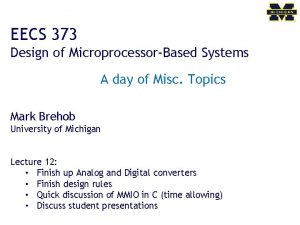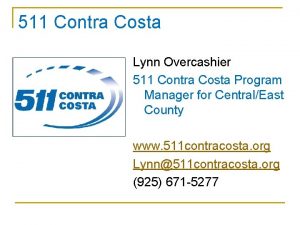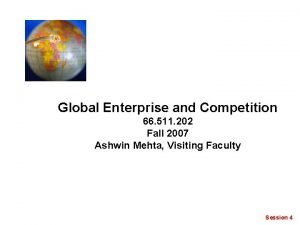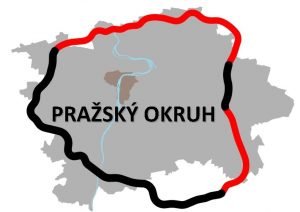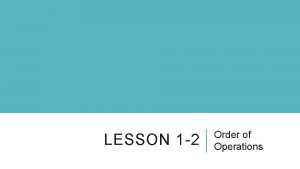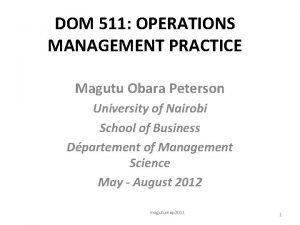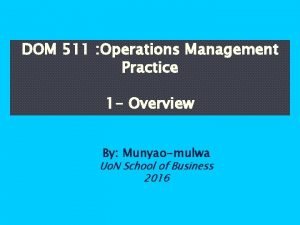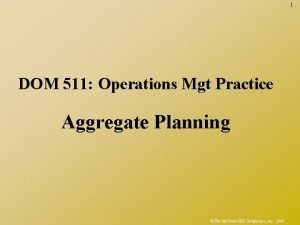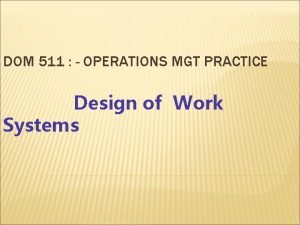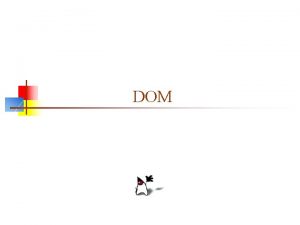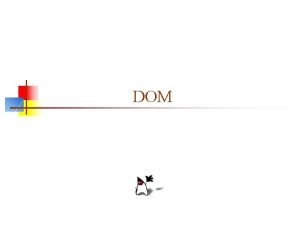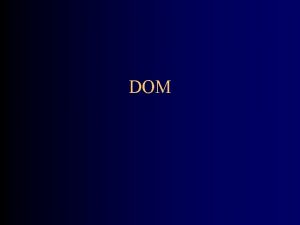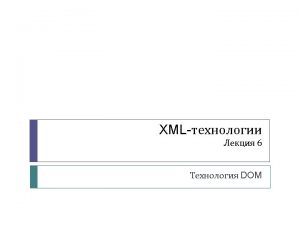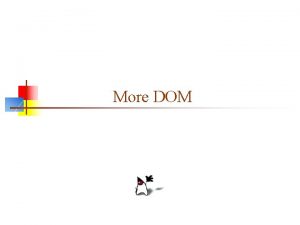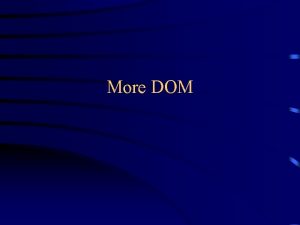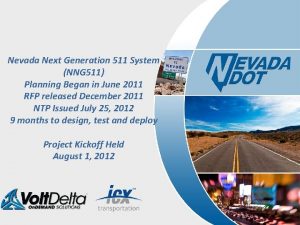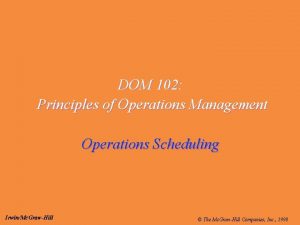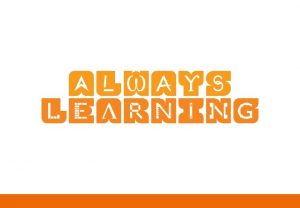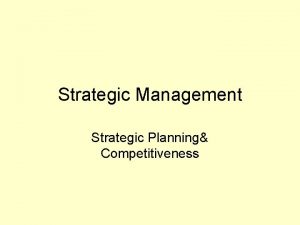DOM 511 Operations Management Practice The strategic role




































- Slides: 36

DOM 511 : Operations Management Practice The strategic role of Operations and Operations Strategy By: Munyao Mulwa Dept of Management Science

WHAT IS STRATEGY? Concerned with meeting existing market needs as well as exploiting opportunities for potential market segments Making the best use of resources & leveraging these resources either alone or with partners Devising and implementing processes that will enable the enterprise to compete & ideally create competitive advantage Concerned with developing capabilities within the firm’s operations that are superior to other competitors and that other competitors either cannot copy or will find it extremely difficult to copy

WHAT IS STRATEGY? While a vision unifies an Organization, a mission states what the firm is about and strategy is says how the organization will achieve the mission Provides Keeps Consistency in Decisions an Organization moving in the right Direction

WHAT IS STRATEGY? Example ( Kai-Z household Pride Ltd) The mission (the ‘what’ element) : ‘to crush, squash and slaughter selling of household utensils and appliances in supermarkets’ (The ‘How element ‘, ->> by locating low cost, variety led utensils & appliances outlets in all major cities & towns in Kenya within 18 months Consider Operations Capabilities Consider capabilities outside the firm

WHAT IS STRATEGY? An Operations Strategy must include at least the following; amounts of capacity required by the organization to achieve its aims; the range and locations of facilities; technology investment to support process and product developments; formation of strategic buyer–supplier relationships as part of the organization’s ‘extended enterprise’; the rate of new product or service introduction; organizational structure – to reflect what the firm ‘does best’, often entailing outsourcing of other activities.

OPERATIONS STRATEGY Customer Needs Corporate Strategy Alignment Operations Strategy Core Competencies Decisions Processes, Infrastructure, and Capabilities 3

What is the role of the operations function? Operations as effector Strategy Operations as follower Operations as leader Strategy Ops Operations implements strategy Operations supports strategy Operations drives strategy

The Strategic Role of the Operations Functions The 3 key attributes of operations Implementing Operations Contribution Be Dependable Operationalise strategy Explain Practicalities Supporting Be Appropriate Understand strategy Contribute to decisions Driving Be Innovative Provide Foundation of strategy Develop long-term Capabilities

OPERATIONS PRIORITIES Cost Quality Delivery Flexibility Delivery Speed Delivery Reliability Coping with Changes in Demand Flexibility and New Product Introduction Speed Other Product-Specific Criteria 4

COMPETING ON COST Eliminate all waste ü Invest in ü ü Updated facilities & equipment Streamlining operations Training & development

COMPETING ON QUALITY ü Please the customer ü Understand customer attitudes toward and expectations of quality

COMPETING ON FLEXIBILITY Produce wide variety of products ü Introduce new products ü Modify existing products quickly ü Respond to customer needs ü

COMPETING ON SPEED Fast moves ü Fast adaptations ü Tight linkages ü

DEALING WITH TRADE-OFFS Cost Flexibility Delivery Traditional Approach Quality Plant within a Plant (PWP) World Class Manufacturing FOCUS Advanced Approaches Trade-offs 5

WORLD-CLASS MANUFACTURING World-class manufacturers no longer view cost, quality, speed of delivery, and even flexibility as tradeoffs. They are order qualifiers & order winners. Order qualifiers - a screening criterion that permits a firm’s products to be considered as possible candidates of purchase e. g on time delivery Order winners – A criterion that differentiates the products or services of one firm from another e. g price, quality & reliability 6

SERVICE BREAKTHROUGHS Service can be an “order winner” Warranty Leases Roadside Assistance Loan Vehicles 7

A FRAMEWORK FOR MANUFACTURING STRATEGY Customer Needs Strategic Vision New and Current Products Performance Priorities and Requirements Quality, Dependability, Speed, Flexibility, and Price Enterprise Capabilities Operations & Supplier Capabilities Technology Systems People R&D CIM JIT TQM Distribution Support Platforms Financial Management Human Resource Management Information Management 8

STRATEGY BEGINS WITH PRIORITIES Consider the case of a personal computer manufacturer. 1. How would we segment the market according to product group? 2. How would we identify product requirements, demand patterns, and profit margins for each group? 3. How do we identify order winner and order qualifiers for each group? 9

Strategy Begins with Priorities 4. How do we convert order winners into specific performance requirements? Competition (Them) Differentiation Us (Core competencies) 10

HAYES AND WHEELWRIGHT’S FOUR STAGE MODEL 1. 2. 3. 4. Internally Neutral Externally Neutral Internally Supportive Externally Supportive

MANUFACTURING’S ROLE IN CORPORATE STRATEGY Stage 1 --Internally Neutral Minimize manufacturing’s negative potential Management control systems Stage II--Externally Neutral Achieve parity with competitors Follow industry practice Stage III--Internally Supportive Support Stage the business strategy IV-- Externally Supportive Manufacturing-based competitive 11

The strategic role of operations can be defined by its aspirations (Hayes and Wheelwright) Give an Operations Advantage n tio of e op bu i r t n ng Correct the Worst Problems ns it o ra Link Strategy With Operations Adopt best Practice Redefine the industry’s expectations co i as re c In Be clearly the best in the industry Internally supportive Be as good as competitors Externally neutral Stop holding the organisation back STAGE 1 Externally supportive Internally neutral STAGE 2 The ability to Implement STAGE 3 The ability to support Strategy STAGE 4 The ability to Drive strategy

FOUR STAGES OF SERVICE FIRM COMPETITIVENESS Stage I. Available for Service Reactive, Stage Firm non-performance-based survival II. Journeyman neither sought nor avoided Reliable but uninspired operation 12

FOUR STAGES OF SERVICE FIRM COMPETITIVENESS (CONTINUED) Stage III. Distinctive Competence Achieved Reputation for meeting customers’ expectations Customer-focused Stage operations--management support IV. World Class Service Delivery Firm name synonymous with service excellence-focus on delighting rather than satisfying customers Continuous learning and improvement of operations 13

STRATEGIC DECISIONS IN OPERATIONS Products Services Capacity Human Resources Facilities Sourcing Processes and Technology Quality Operating Systems

PRODUCTS & SERVICES ü Make-to-order ü ü Make-to-stock ü ü Made to customer specifications after order received Made in anticipation of demand Assemble-to-order ü Add options according to customer specification

PROCESSES & TECHNOLOGY q Job shop q q Batch production q q Produce large volumes of standard product for mass market Mass customization q q Process many jobs at same time in batch Mass production q q Production of product to customer order Very high volume unique products Continuous Production q High volume commodity products

CAPACITY & FACILITIES q How much capacity to provide q Size of capacity changes q Handling excess demand q Hiring/firing workers q Need for new facilities

FACILITIES q Best size for facility? q Large or small facilities q Facility focus q Facility location q Global facility

HUMAN RESOURCES q q q q Skill levels required Degree of autonomy Policies Profit sharing Individual or team work Supervision methods Levels of management Training

QUALITY q Target level q Measurement q Employee q Training involvement q Systems needed to ensure quality q Maintaining quality awareness q Evaluating quality efforts q Determining customer perceptions

SOURCING q Degree of vertical integration q Supplier selection q Supplier relationship q Supplier quality q Supplier cooperation

OPERATING SYSTEMS Execute strategy daily q Information technology support q Effective planning & control systems q Alignment of inventory levels, scheduling priorities, & reward systems q

STRATEGY DEPLOYMENT Mission Vision Business Environment Corporate Strategy Marketing Strategy Operations Strategy Voice of the Customer Financial Strategy

STRATEGY DEPLOYMENT From A Formulating => Making it happen need for breakdown/ translation at department level A need to go from (long term) Strategic Goals to daily Tactics & Actions A Strategic Planning Hierarchy is required

READING ASSIGNMENT Download two articles from the e-learning portal & read them; Too busy to develop an operations strategy Operations strategy: genealogy, classification and anatomy
 Objectives of operations management
Objectives of operations management Retail management strategies
Retail management strategies Resource based model
Resource based model Analysing the 6 strategic options megxit
Analysing the 6 strategic options megxit Royaume de clovis en 511
Royaume de clovis en 511 Kansas 511 road conditions
Kansas 511 road conditions Eecs 511
Eecs 511 511 contra costa
511 contra costa Pet 511 kev
Pet 511 kev 511
511 Rta goroo
Rta goroo Cse 511
Cse 511 Adw 511
Adw 511 Circulation 511
Circulation 511 Stavba 511
Stavba 511 Sokp 511
Sokp 511 What is web role and worker role in azure
What is web role and worker role in azure Krappmann role taking
Krappmann role taking Role conflict occurs when fulfilling the role expectations
Role conflict occurs when fulfilling the role expectations Flexibility in operations management example
Flexibility in operations management example The role of housekeeping in hospitality operations
The role of housekeeping in hospitality operations Quality management in operations management
Quality management in operations management Operations management chapter 12 inventory management
Operations management chapter 12 inventory management What is tqm
What is tqm Why strategic planning is important to all managers
Why strategic planning is important to all managers Strategic fit vs strategic intent
Strategic fit vs strategic intent Tirole
Tirole 1-2 skills practice order of operations
1-2 skills practice order of operations Hát kết hợp bộ gõ cơ thể
Hát kết hợp bộ gõ cơ thể Lp html
Lp html Bổ thể
Bổ thể Tỉ lệ cơ thể trẻ em
Tỉ lệ cơ thể trẻ em Chó sói
Chó sói Tư thế worms-breton
Tư thế worms-breton Alleluia hat len nguoi oi
Alleluia hat len nguoi oi Môn thể thao bắt đầu bằng chữ f
Môn thể thao bắt đầu bằng chữ f Thế nào là hệ số cao nhất
Thế nào là hệ số cao nhất






